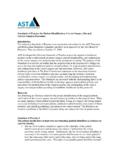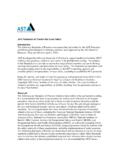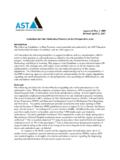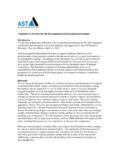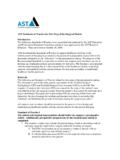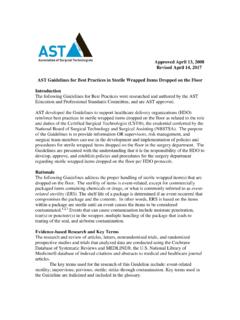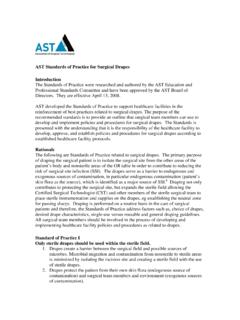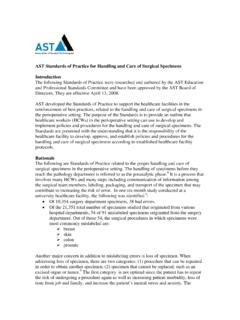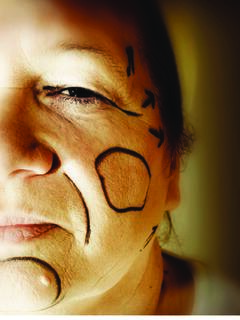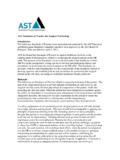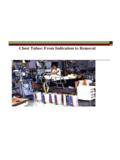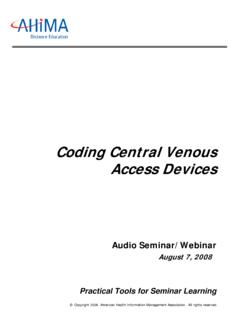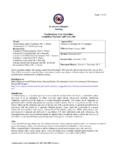Transcription of Repeat - AST
1 Repeat Cesarean Section B !" # $ P % & ' ' & ( K & $ ) $ ! , # * + Reports of surgical removal of a fetus from its dead or dying mother have been dated from as far back as 3000 BCE in ancient Egypt. The procedure was performed at that time so that the fetus and mother could have separate An ancient Roman law known as lex caesaria required the proce dure be performed on dying mothers as an attempt to save the life of the fetus. The name of this law is sometimes cited as the origin of the procedure s Use of the crude procedure continued into medieval times with reported cases in Germany from the early 1400s and from France in the late 1500s.
2 In 1663, a Dutch physician published illustrations of the pro cedure in a book on operative gynecology, and in 1738 an Irish midwife is reported to have performed the procedure JANUARY 2008 The Surgical Technologist Bayley 13 Mortality rates remained high, though. It is estimated that 50 to 75% of women did not sur vive the procedure. Massive infection and internal bleeding were the biggest challenges physicians faced, so the procedure remained a last-resort option. Since anesthesia wasn t discovered until 1847, the agonizing pain inflicted on the mother was also a factor in deciding whether or not the procedure was necessary. It wasn t until the early 1900s that cesarean section became a more acceptable alternative to other options of that time, including high forceps delivery and cutting the pubic bone.
3 By 1960, the mortality rate was near zero, and today it is esti mated that 25 out of every 100 births in the US are performed by cesarean section. iiCation Table 1. Indications for cesarean section Adapted from Surgical Technology for the Surgical Technologist: A Positve Care Approach. Thomson Delmar Learnng. 2004 tegory IndicaMaternal Diseases Eclampsia or severe preeclampsia; Cardiac disease; Diabetes mellitus; Cervical cancer; Herpes Prior surgery of the uterus Cesarean section (especially classical type); Previous rupture of the uterus; Full-thickness myomectomy Obstruction of the birth canal Fibroids; Ovarian tumors Other Uterine rupture; Failure to progress (etiology unknown); Maternal demise Fetal Fetal distress (sustained low heart rate) Prolapse of the umbilical cord Malpresentation Breech; Transverse; Brow Multiples (depends on number and presentation) Fetal demise Maternal/ Fetal Dystocia Cephalopelvic disproportion.
4 Failed induction of labor; Abnormal uterine action Placental Placenta previa Placental abruption 289 JANUARY 2008 1 CE CREDIT C A S E S T U D Y : R E P E A T C E S A R E A N S E C T I O N The patient is a 26-year-old female, gravida 4, para 3 with 41 weeks of high-risk pregnancy, and late prenatal care. According to the patient s medical chart, she has reported abdominal pain, edema in the feet and legs, and no contraception use prior to conception. The patient is morbidly obese. Weight: 325 lbs Height: 5 ft, 5 in BP: 119/45 Temperature: F Pulse: 82 bpm Respirations: 20/minute saturation: 100% O2 P R E O P E R A T I V E D I A G N O S T I C T E S T I N G Preoperative diagnostic testing included a uri nalysis, a prenatal panel, a drug screen and a serology study.
5 Results for the urinalysis and prenatal panel were within acceptable ranges. Results from the drug screen and serology study were negative. The findings of the preoperative ultrasound were, Single living intrauterine pregnancy, transverse lie, anterior grade II placenta with normal amniotic fluid index of cm. Heart rate of 137 bpm. P R E O P E R A T I V E D I A G N O S I S The patient s principal diagnosis was breech pre-sentation-footling. Secondary diagnosis and con cerns expressed by the patient s physician were the possibility that the umbilical cord was wrapped around the baby s neck, the patient s weight, the potential for fetal or placental problems, and pre vious cesarean section.
6 R O O M P R E P A R A T I O N S u p p l i e s N Prep set N Cesarean section pack N Basin set N Gloves N Bulb syringe, one per infant N Cord clamps, two per infant N Cord blood container, one per infant The Surgical Technologist JANUARY 2008 14 2 N Blood gas containers available N DeLee suction device available N Mity vac delivery system N Suction canister N Lap sponges, 18x18 N Temperature strip N Surgical clippers N Spinal anesthesia tray N Hyperinflation system N O cannula N Pediatric O mask 2 N 12' suction tube connection N Laparotomy drape or specialized C-section drape N Surgeon-specific sutures and dressings E q u i p m e n t N Suction apparatus N Electrosurgical unit (In this case, the ESU was set at Cut 60/Coag 60, per surgeon request.)
7 N Fetal monitor N Neonatal warming bed, one per infant I n s t r u m e n t a t i o n N Knife handles, #3 N Needle holders N Tissue forceps, short and long N Adson tissue forceps N Kelly clamps, short and medium N Rochester-P an clamps N Rochester-Ochsner clamps N Mayo scissors, curved and straight N Metzenbaum scissors N Bandage scissors N De Lee universal retractor or bladder blade from Balfour retractor N Richardson retractors N Goelet or US Army retractors N Allis clamps I n t r a v e n o u s s o l u t i o n s N Normal saline, 500 ml, for irrigation N Lactated Ringers, 1000 ml N A secondary IV set should be ready, if needed. Blessing A n e s t h e s i a N Spinal N Cefazolin sodium, 1 g N Oxytocin, 10 units added to IV bag (with a second IV bag ready with 20 additional units to be used when directed by surgeon) P A T I E N T P O S I T I O N I N G The entire surgical team should be in the room prior to the start of the procedure, including the anesthesia provider, surgeon, surgical tech nologist, circulator, as well as the neonatal team, including a registered nurse, a neonatologist (if necessary) and a respiratory therapist.
8 After an informed consent, the patient was taken to the The patient was morbidly obese with a large pannus. The umbilicus and pannus hung below the patient s pelvic bones. JANUARY 2008 The Surgical Technologist 15 The patient was transferred to the operating table and placed in the supine position. A bolster was positioned under the patient s right hip to offset abdominal weight and thus reduce uterine pressure on the vena cava. The safety strap was secured, and a Foley catheter was inserted. A blood pressure cuff, thermometer, ECG electrodes and a pulse oximeter were placed on the patient. A grounding pad was then posi tioned as close to the operative site as possible, taking care to avoid bony prominences.
9 S K I N P R E P A R A T I O N A N D D R A P I N G Skin preparation solution was applied from mid-chest to the pubis and to the sides of the patient all the way down to the operating room table as far as possible. Next, the vaginal region extend ing to the inner thighs was prepared. Prior to preparation, the circulator shaved the area with disposable clippers. Folded towels were used to square off the operative site, and a specialized C-section drape was placed. P R O C E D U R A L O V E R V I E W After completing the time-out procedure, a #10 blade was used to incise the skin via a mid- Miller line vertical incision. The skin and adipose tissue were retracted, and the incision was carried to the level of the fascia.
10 The fascia was incised at the midline and car ried laterally on both sides using Mayo scissors. The posterior fascia was bluntly dissected from the rectus abdominus muscle and secured with two Kocher clamps. Sharp dissection of the aponeurosis was accomplished superiorly to near the umbilicus and inferiorly to the symphysis pubis using Mayo scissors. The peritoneal cavity was entered atraumati cally via a longitudinal incision extended to the length of the fascial opening. The uterus was pal pated to determine fetal position. The vesicouterine fold of the peritoneum was incised, and the bladder was freed from the uterus with Metzenbaum scissors and retracted inferiorly with a bladder blade.
